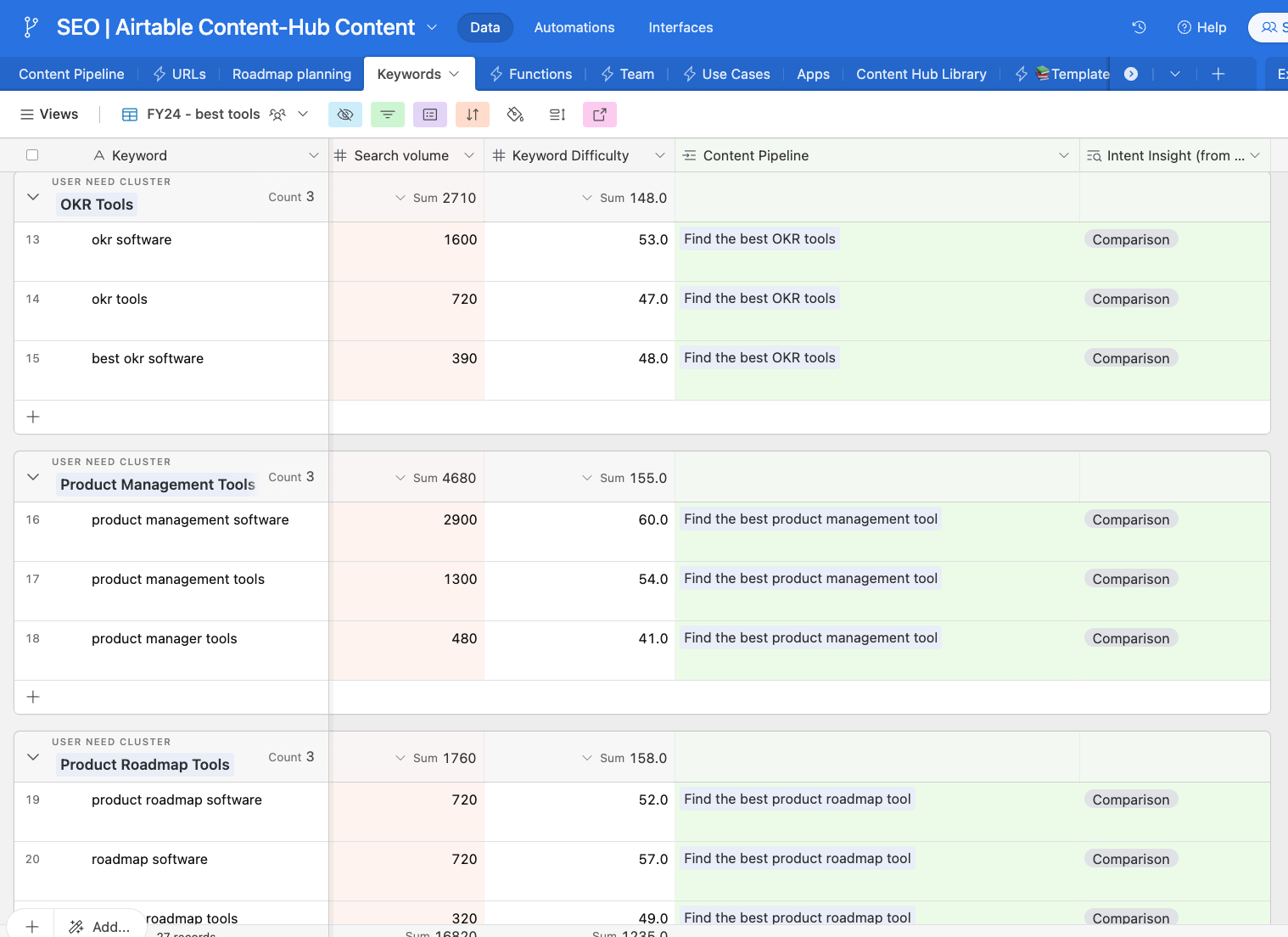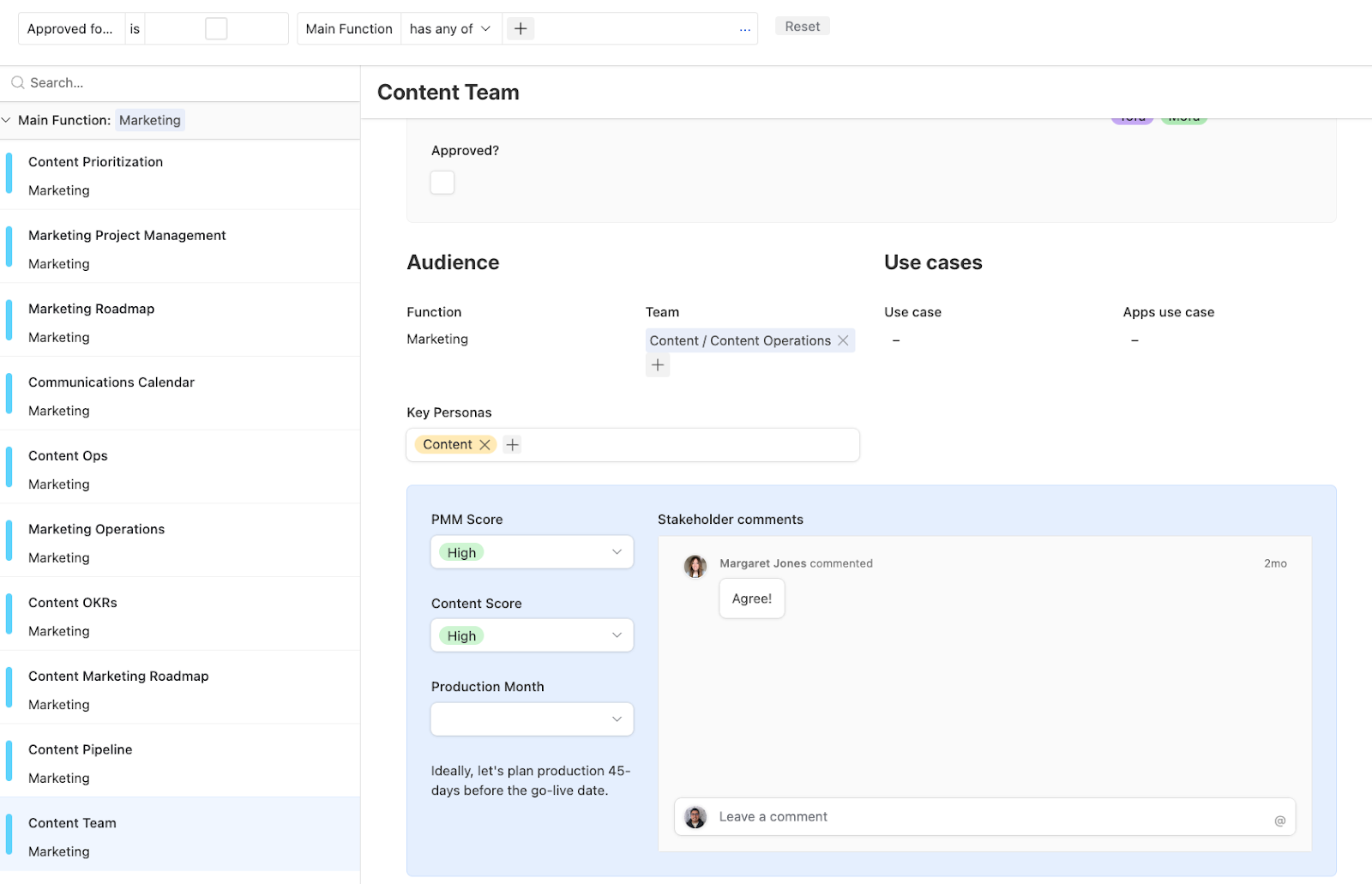SEO teams spend a lot of time hunting for the right data, like keywords or specific performance metrics. But what if they can access that data at their fingertips, anytime?
SEO (which stands for “Search Engine Optimization”) and SERP (“Search Engine Results Page”) are critical for companies looking to improve their online visibility and attract more traffic. But with so many moving parts (read: dozens, even hundreds of keywords), it can be tough to stay organized and ensure everything runs smoothly.
This is where a connected apps platform like Airtable comes in handy. By providing a centralized location for all SEO-related tasks and data, Airtable makes it easy to collaborate with colleagues, manage projects, and stay on top of to-do lists, freeing up more time to focus on higher-level strategy and analysis.
Below, we show how to get started with tracking SEO in Airtable, then give you three concrete tips for managing your workflow.
Getting started in Airtable
Building a comprehensive base to manage SEO and SERP gets easier when you know what data to track. So which metrics are the most important for SEO teams? Start with these six.
- Organic traffic: Refers to visitors who find your content on the SERPs, rather than through a paid ad.
- Backlinks: Links that point to external web pages.
- Page speed: How fast the content of a page loads.
- On-page optimization: The process of optimizing your web pages to improve their position in search rankings.
- Click-through rate (CTR): The percentage of people who visit your website after finding your web pages in the SERPs.
- Conversion rate: The percentage of people that complete a desired goal (conversion) out of the total number of visitors to your web page.
Once you understand your desired metrics, start setting up your base by importing data into tables and customizing fields. We recommend starting by creating a table for all of your keyword research.
Create a comprehensive keyword research repository
Building a repository in Airtable is a powerful way to organize and manage the keywords that are important for your SEO strategy.
But what if you’re already using another tool to conduct your keyword research? No problem–in Airtable, you can connect other sources to your base and import data, so teams can get all the up-to-date information they need in one place.

To populate your repository, import your existing research into a new table, then customize your fields. You can do this by adding a new table and choosing the relevant source to import from in the dropdown, like CSV file, Google Sheets, or Microsoft Excel.
Some data we recommend tracking alongside your keywords include:
- Parent keyword
- Search volume
- Ranking difficulty
✏️ Pro tip: Airtable’s comment functionality lets you add notes to each record so that you can provide additional context or insights.
As you continue your research and add new keywords, your repository will become a critical way to optimize content and track search engine rankings.
Build a content pipeline around target personas
Now that you have one table fleshed out, add more tables that can link together. With Airtable, you can easily connect datasets to provide immediate context.
For example, we recommend creating a content pipeline table that’s built around target personas; by linking keywords, SEO content topics, and other data to each target persona, your content strategy aligns with your audience’s interests.
Start by listing your audiences and key persona needs, and segment them by team (ex. Marketing leaders, product and design teams).
Building a content pipeline that's target persona-centric helps us identify relevant resources–templates, ebooks, demos, webinars–to path users to further engagements that drive business impact.
As you brainstorm ideas for content, assign each idea to one or more target personas and add it to the content pipeline.
✏️ Pro tip: You can also use Airtable's calendar view to visualize the content schedule and ensure that you publish a mix of content types that appeal to each persona.
Be sure to connect the keyword research table to the content pipeline table so you can associate keywords with the appropriate SEO content topics and personas. Add a rollup field that aggregates keyword volume (the number of searches for a particular keyword in a given timeframe) to see each topic’s ranking opportunity.
Get stakeholder signoffs with an approvals interface
With a connected apps platform, you can collaborate on data that stays updated in real-time.
SEO teams often need stakeholder signoffs and feedback on content topics–creating an approvals interface in Airtable can make this process smoother and more efficient.
Use Interface Designer to create a new, interactive interface that’s built using your base data. We recommend starting with the record review layout, which displays the details of multiple records from one table (ex. All of the SEO content topics that are under consideration).

Consider organizing SEO content topics by main function (see above). This organized list lets stakeholders quickly move from one content topic to the next.
Then, add elements that provide stakeholders with the context they need to make and share feedback. At the top of the interface, try listing each content topic (ex. How to create a marketing plan in 4 steps), followed by the funnel stage.
Next, add a comment element to encourage stakeholders to engage in discussion. Finally, add a button that stakeholders can click to change the content topic’s status from “not approved” to “approved,” and/or another that changes it to “needs further review.”
With interfaces, you can create a personalized, interactive experience for each stakeholder that encourages them to take action on work.
By creating a customized base and interfaces for SEO and SERP tracking in Airtable, you can capture the data you need, analyze it in myriad ways, and collaborate with your team. And a better SEO workflow leads to better SEO performance.
Put these tips to the test! Create an interface today for content approvals.